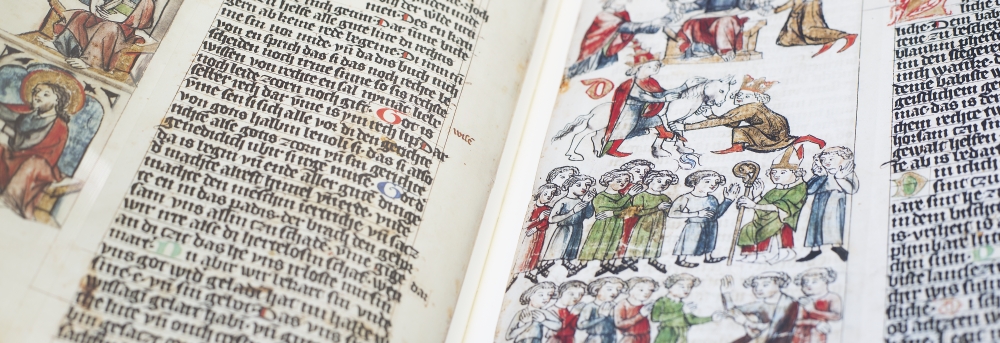
Facsimile of the illuminated manuscript of the Wolfenbüttel Sachsenspiegel (Photo: Kulturhistorisches Museum Magdeburg)
The Sachsenspiegel is both a record of medieval Saxon customary law and the first major work of German prose. It is considered to be the most significant medieval law book. It is believed to have been authored by the legal expert Eike von Repgow, whose family settled in the vicinity of the village of Reppichau near Köthen in the mid-12th century and who was a vassal of the Archbishop of Magdeburg. Virtually nothing more is known about his life. His existence is documented, however, since he appears in several charters as a witness to legal transactions in the region of Saxony. The quality of his work indicates that he had an above-average education for his day and knowledge of the political situation.
Eike von Repgow translated his earlier original Latin compilation of Saxon Law into German at the behest of Count Hoyer of Falkenstein. Both the author and his lord are mentioned in the rhyming preface to the Sachsenspiegel. Various references in and to the work narrow its date of authorship down to the period between 1220 and 1235. Although nothing is known about its concrete place of origin, the Sachsenspiegel is presumed to have been written in the vicinity of an abbey library east of the Harz foothills. The author himself added to and revised his work several times and passages were added by other authors over time before the so-called vulgate appeared in the early 15th century.
The reasons for drafting one of the oldest law books are rooted in the circumstances of those days. At the time, legal systems were normally passed down as orally transmitted customary law. The influx of outside populations from other parts of the empire into the regions of Saxony, which were already diversely settled anyway, increased substantially in the wake of eastward expansion. The principle of personality in force in the Middle Ages permitted immigrants to retain their own laws, thus leading to the coexistence of different legal systems. Laws needed to be put down in writing purely and simply to counter the danger of conflation or even loss of one’s own native law.
In his text, Eike von Repgow primarily dealt with peasant and feudal legal relationships, thus giving rise to the division into customary law and feudal law. He also dealt with other legal issues, however, including special interests of certain groups such as Jews, merchants, clergy, and members of different nations, problems of family, inheritance and marriage law, and provisions on medieval legal proceedings, crime and punishment. The Sachsenspiegel even includes simple rules of the road, once again revealing the diversity and complexity of medieval legal systems.
Although the Sachsenspiegel was a private and thus unofficial compilation, it was frequently treated as a standard text in the ensuing centuries far beyond the author’s home territory. The Sachsenspiegel spread together with Magdeburg law along trade routes, especially to Eastern Europe. Over 400 German as well as Latin, Russian, Polish, Czech, Ukrainian and Dutch versions of the manuscript have survived.
The Sachsenspiegel was the model for other law books and remained in force in some regions well into the 19th century. Some of the Sachsenspiegel’s fundamental legal concepts still influence present-day legal systems.
Literature:
Mamoun Fansa: Der sassen speyghel. Sachsenspiegel – Recht – Alltag. 2 Vols. Oldenburg 1995.
Heiner Lück: Magdeburg, Eike von Repgow und der Sachsenspiegel, in: Magdeburg. Die Geschichte der Stadt 805−2005. Ed. by Matthias Puhle, Peter Petsch. Dössel 2005, p. 155 ff.
Heiner Lück: Sachsenspiegel und Magdeburger Recht. Europäische Dimensionen zweier mitteldeutscher Rechtsquellen
(Adiuvat in itinere V). Hamburg 1998.
